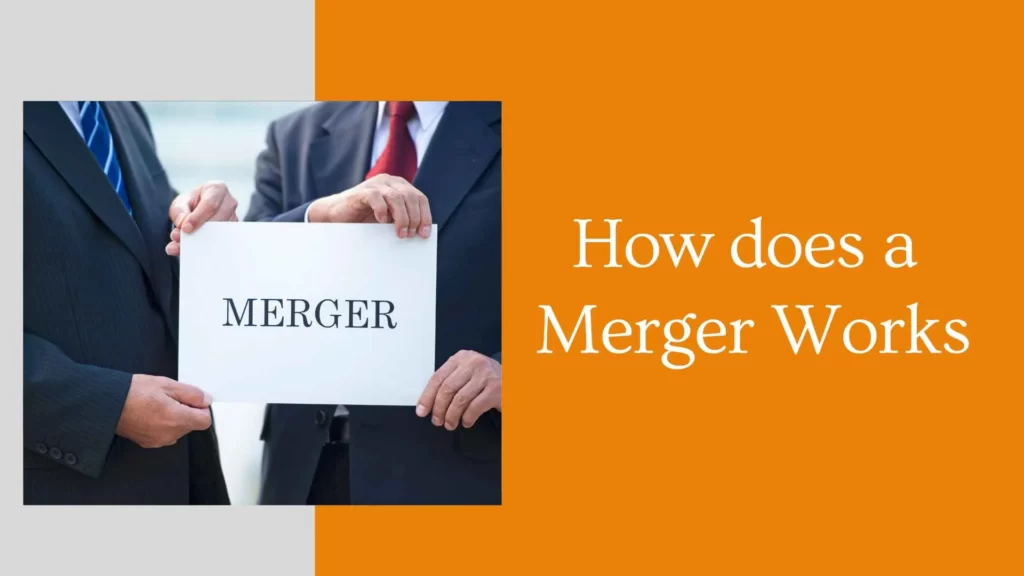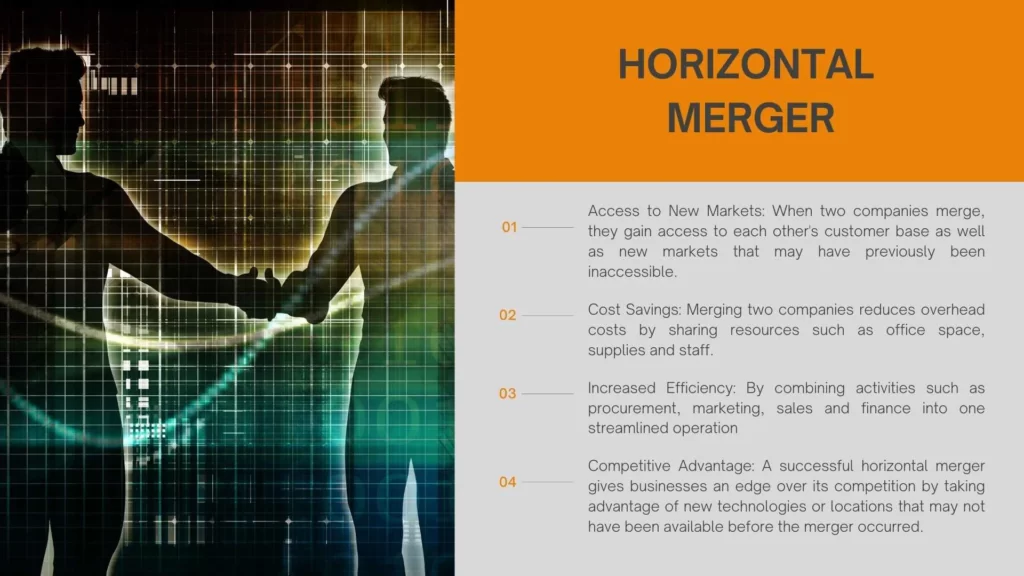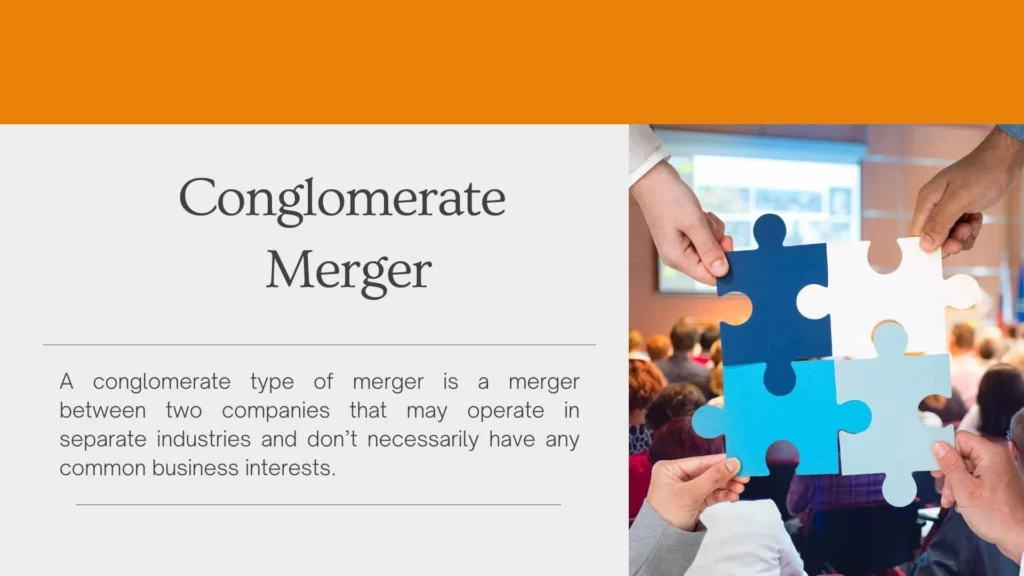Overview
A merger is a business transaction in which two companies combine forces to form one larger entity. The type of merger can be either horizontal (two businesses operating within the same industry) or vertical (a business with operations at different stages of production). By combining their respective resources and capabilities, the two companies have the potential to achieve economies of scale and improved competitive advantage.
Although mergers often present a lot of potential for growth and profitability, it is important to understand which type of merger is best for your company. Horizontal mergers are attractive when there is a lack of competition in an industry, as they can give one company significantly more market share. Vertical mergers create efficiencies in production by combining a supplier and customer, making it easier to streamline operations.
No matter what type of merger you are considering, it’s essential to do plenty of research before proceeding. In addition to understanding the advantages and disadvantages associated with each type of merger, you should also consider the potential financial impact on both companies. Additionally, you should also pay attention to any legal implications associated with the transaction itself.
By having an understanding of what type of merger are available, you will be able to make an informed decision about whether or not a merger is right for your business. By evaluating all aspects carefully and doing your due diligence beforehand, you can ensure that your company is set up for success post-merger.
How does a Merger Works

Understanding a corporate type of merger is key to understanding the current landscape of business. A merger, by definition, is the combining of two companies into one. This typically represents both companies unifying their ownership and stock as well as their respective assets and liabilities.
Typically, one company will agree to buy the other’s stock in exchange for cash or stock of its own. This usually means that shareholders of the acquired company will receive either cash or shares in the acquiring company’s stock. On the other hand, shareholders in the acquiring company will keep their holdings intact (and potentially even increase in value).
When planning a merger, it’s important to consider its potential effects on competition. Depending on regulations, a merger may help eliminate market competition, expand an existing market’s reach, or create a new type of monopoly – all ventures best undertaken with careful consideration of potential risks and rewards. In general, mergers are seen as beneficial for both companies as well as for customers who may enjoy increased product variety and quality due to better resources and improved integration efforts.
Mergers also serve to join together existing products which may give rise to entirely new products that wouldn’t otherwise have been possible without such collaborations. The four main types of mergers are horizontal mergers (combining with competitive businesses), vertical mergers (merging different business stages), conglomerate mergers (merging dissimilar businesses) and congeneric mergers (merging related businesses). Each has its own benefits and drawbacks; understanding each type can help inform your decision-making process should you consider a merger yourself.
Have a look at the best PG Program In Investment Banking with PLACEMENT GUARANTEE
Reasons for Merging
Mergers can happen for many reasons – from diversifying product lines to increase market share. Merging can help companies achieve economies of scale, by eliminating duplicate costs like salaries and infrastructure. Additionally, mergers can provide access to new markets and technology or increase profitability by cutting costs. Companies also merge so that they can increase their competitive advantage over others in the same industry.
Regulatory Requirements
Mergers must comply with all relevant laws and regulations. Businesses must comply with antitrust regulations to assess if a merger would create an unfair level of competition in the marketplace. Companies must also follow federal disclosure requirements when informing shareholders and customers of their intent to merge. Depending on the size of each company involved in a merger, other regulatory bodies may have to be consulted as well such as exchange markets like NASDAQ or NYSE.
Preceding Evaluation Process
Before agreeing to a merger, both companies need to go through an evaluation process that looks at both parties’ assets, liabilities and operations among other things. This evaluation helps ensure that both parties are entering into an informed agreement with mutual benefits for all stakeholders in terms of long-term value creation. The financial analysis should consider topics such as cash flows and profits available post-merger, operating expenses available premerger etc.
Consequences of merger
A merger is a type of corporate transaction that combines two companies into a single, new entity. It’s an attractive option for businesses looking to expand their portfolios or gain greater market share without having to start from scratch. However, it is important to understand how mergers work and the consequences they can have in order to make informed decisions about your business’s future.
Impact on stakeholders
Once the type of merger has been determined, you must consider how this change may affect stakeholders such as shareholders and employees. In most cases, stockholders can exchange their existing shares for those of the new combined company; however, they must take into account any tax implications that may come along with this transaction. Employees may also be affected depending on whether their job roles remain unchanged or if layoffs occur as part of cost-cutting measures by the newly merged entity.
Merged entity formation
Forming a merged entity involves several steps including creating a board of directors made up of members from both premerger companies, deciding on leadership structure (CEO/CFO/etc.), and setting up shareholder agreements that define voting rights as well as profit and loss share between parties involved in the transaction. Depending on your needs and goals, other documents may need to be signed as well such as contracts for licensing or intellectual property sharing between Parties.
Forms of Mergers

When it comes to mergers, there are two type of merger — absorption and consolidation. Depending on your business situation, one of these type of merger could be the right choice for you. Understanding the differences between them can help you make an informed decision about which type of merger best suits your needs.
Absorption, or purchase merger, is the most common type of merger and involves one company acquiring another. The acquiring company absorbs the operations and assets of the other business. One major benefit of an absorption merger is that it allows for a smooth transition and greater efficiency due to the lack of paperwork involved in combining two companies’ operations and assets.
The other type of merger is consolidation or a pooling of interests merger. This form involves two separate companies combining to create a brand new entity with its own identity. Unlike an absorption merger, consolidation does not require one party to take ownership over another; instead, both parties maintain their separate identities but come together under one umbrella organization.
Furthermore, by combining resources from both enterprises into one larger entity, consolidation can offer increased financial opportunities and greater potential for growth than an absorption merger.
When considering which type of merger is right for you and your business objectives, ask yourself questions such as: Will I need to acquire another business operation and assets? Do I want my business to maintain its independence while gaining access to more resources? What are my long-term goals?
Your answers will help determine which form of merging — absorption or consolidation — is right for you and your company. Ultimately, merging can provide numerous benefits beyond just cost savings; it can help streamline processes while creating increased efficiency throughout your entire organization. Following are some Different Types of Mergers.
Also, Visit one of the top Financial Modelling course with a PLACEMENT GUARANTEE
Horizontal Merger

A horizontal merger is a type of merger in which two businesses of the same size and scope combine. This type of merger or corporate integration can give each business an advantage by providing access to a larger market, greater resources and economies of scale. By pooling their resources, both businesses can reach more customers, increase their market presence, and gain cost savings through shared facilities such as manufacturing plants and distribution centers.
If you’re considering a horizontal type of merger for your business, it’s important to recognize the potential benefits that come along with this type of integration. Here are just a few:
- Access to New Markets: When two companies merge, they gain access to each other’s customer base as well as new markets that may have previously been inaccessible. This expanded reach can help build brand recognition and loyalty for both parties involved.
- Cost Savings: Merging two companies reduces overhead costs by sharing resources such as office space, supplies and staff. This allows the merged entity to increase profits without the need for additional investments in infrastructure or personnel.
- Increased Efficiency: By combining activities such as procurement, marketing, sales and finance into one streamlined operation, it’s easier to eliminate redundancies and streamline processes for greater efficiency across different departments.
- Competitive Advantage: A successful horizontal merger gives businesses an edge over its competition by taking advantage of new technologies or locations that may not have been available before the merger occurred.
Overall, a horizontal merger can be an effective way to expand your business while improving efficiency and boosting profits making it an attractive option for many growing organizations looking to expand their reach in today’s competitive marketplace!
Vertical Merger

A vertical merger is a type of merger that occurs when two companies at different stages of production or distribution join together. This type of merger allows companies to combine their activities to create a powerful company that can produce and distribute products more efficiently as well as give them access to new markets. Vertical mergers have become popular in recent years, with many large companies seeing the potential advantages they bring.
One of the main benefits of a vertical merger is that it creates economies of scale and cost savings for both companies joining forces. The efficiency gains from a vertical merger typically come from removing duplicated activities and increasing the product range for both companies without having to develop new products.
This makes it easier for businesses to increase their market share, access new customers and reduce costs by eliminating overlapping functions such as manufacturing processes, sales channels and transportation methods.
Another advantage of a vertical type of merger is that it provides greater control over the supply chain for products and services. By combining two separate organizations into one, companies are able to gain enhanced visibility into processes and streamline operations which further reduces costs while improving efficiency. Furthermore, it provides economies of scope which can make production or distribution more efficient than when done independently by either company alone.
Vertical mergers can also help expand geographic reach by providing access to each other’s markets or customers which would otherwise be impossible due to legal restrictions or logistical issues such as distance or transportation problems. This allows businesses to enter new markets quickly while reducing risks associated with competing in foreign markets where they may lack expertise or local knowledge.
Conglomerate Merger

A conglomerate type of merger is a merger between two companies that may operate in separate industries and don’t necessarily have any common business interests. It is generally used to diversify the companies’ portfolios, for tax gains, or to gain access to valuable resources. It is an attractive option for many businesses looking to enter a merger due to its ability to capitalize on different markets and create larger-scale industries.
When considering a conglomerate merger, both merging companies must be aware of the risks associated with that kind of venture. For example, each company will need to assess their respective strengths and weaknesses before deciding whether or not it makes sense for them to combine resources. Also, there may be inconsistencies in terms of profits and losses between the two entities which could become an issue upon combining operations.
The types of companies entering a conglomerate merger vary greatly but typically involve large corporations with access to a variety of markets and investments. A successful example is the joint venture between AT&T and Time Warner, two media giants uniting in 2018 after regulatory approval was granted. Other examples include Apple buying Akamai Technologies in 2016 (a content delivery network) or Amazon buying Whole Foods Market in 2017 (a grocery retailer).
For many businesses looking to explore different markets or gain access to valuable resources such as talent or technology, entering into a conglomerate-type merger can make sense.
It also allows companies greater access to capital financing as well as increased efficiency from shared operational costs and functions across multiple industries. Furthermore, exploring opportunities for mergers can provide enhanced growth potential for both sides involved as financial returns are distributed appropriately between the parties at play.
Market-Extension Merger

A market extension type of merger is a strategic move that can benefit your business in a variety of ways. As the name suggests, it involves extending an existing market by merging with another company or entering into a new one. By doing this, you are able to enhance your revenues and profits, reduce costs and wastage, diversify your product offerings, increase efficiency and control, enter new markets quickly, and expand existing markets.
This type of merger is beneficial because it allows businesses to capitalize on their strengths in order to better compete in the marketplace. Market Extension mergers give companies the ability to acquire additional resources that can be used to develop new products or services. This could include access to a more diverse customer base as well as physical assets such as manufacturing facilities that can help drive growth and profitability.
By expanding its market reach through such combinations, businesses can experience cost savings from economies of scale meaning they can produce items more efficiently while fewer resources are required due to the extended product range. They also have the advantage of increasing their bargaining power when it comes to negotiations with suppliers and customers alike.
In addition, market extension mergers allow businesses to enter into new markets quickly without significant capital outlays – which can be extremely advantageous for smaller companies that may not have the resources for traditional entry strategies like advertising campaigns or invest heavily in research & development efforts.
Overall, if done correctly, a market extension type of merger is an effective way for businesses to gain access to new consumers and markets while simultaneously enhancing their existing ones by leveraging each other’s strengths and capabilities. With careful planning and implementation, you can use this type of merger strategy effectively to obtain
Product-Extension Merger
This type of merger is when two companies join forces in order to strengthen their core product or service offerings or to extend their market reach to new customers. It’s a great way for companies to increase their competitiveness and make better use of resources.
It’s important to understand the advantages and disadvantages of this type of merger, as well as the regulatory requirements that must be met in order for it to be successful. The main advantage is that it allows companies to leverage each other’s strengths and expertise in order to create more innovative solutions for customers.
Additionally, it can open up new markets and provide access to valuable resources. However, there can be risks associated with this merger, such as potential loss of control over business operations, or a mismatch in corporate culture that could lead to issues down the line.
When it comes to regulatory requirements, product extension type of mergers must adhere strictly to the rules outlined by governing bodies such as the Competition Act (in Canada). This means undergoing anticompetitive reviews and engaging both parties in a comprehensive due diligence process before any agreements are finalized.
As with any merger, there will also be implications regarding ownership rights, revenue-sharing arrangements and other legal elements that need consideration before moving forward with the transaction.
Overall, product extension-type mergers offer tremendous advantages for companies looking to get ahead in their industry – but it’s important for business owners and managers alike to understand what they’re getting into before taking the plunge. By being aware of both the potential benefits and drawbacks associated with this type of merger – as well as keeping abreast of all applicable regulations – companies can ensure
Benefits of Using Mergers
Mergers can offer a range of benefits to businesses of all sizes. When two companies join forces, they create a combination that can result in financial stability, expanded opportunities and access to new markets, and more efficient use of resources and assets. Let’s take a look at some of the key benefits of merger for businesses.
Financial Stability: Joining another company through mergers can bring about financial stability. Through the pooling of each company’s assets and resources, merged entities can increase their ability to meet short-term obligations with greater ease, as well as increase their chances of long term success.
Economies of Scale: Mergers also create economies of scale, which can lead to reduced costs due to increased efficiency and productivity. By combining different departments such as marketing, IT and accounting together, companies are able to reduce redundancy costs in areas such as product design or customer service. This allows them to focus their resources on growth initiatives that build competitive advantage in the industry.
Expansion Opportunities: By merging with another business, companies gain access to a larger market share through the combined entity’s products or services. This gives them a better chance at competing against bigger rivals in their industry while also expanding their customer base and revenue streams.
Cross-Market Access: Merging companies not only gain access to each other’s existing markets but also have the potential to enter international markets as well – something which would be difficult for either business if it remained separate from one another.
The most obvious benefit that comes from mergers is the pooling of resources and assets from two separate companies. By joining forces, both companies can access more capital and expertise than either one could on their own.
This provides opportunities for investment in new technologies, growth initiatives, and other activities that will help the company succeed in the long run. In addition to the pooled resources, businesses can also look forward to tax advantages from the newly formed entity due to different regulations associated with merging companies.
Conclusion
In addition to financial benefits, mergers can help reduce labour costs as well. By combining forces, businesses have access to larger talent pools as well as other workforce-related cost savings such as consolidating senior management teams or shared HR departments. This is especially beneficial for smaller companies looking to expand without having to make significant investments in human resources right away.
Finally, increased competitiveness is another great advantage of using mergers. Companies that merge can leverage their combined capabilities and resources when competing with larger competitors in the market space by offering more attractive products and services to customers at competitive prices. This helps them remain competitive in a highly saturated field while still having a clear edge over their rivals who don’t have access to the same level of expertise or funds as merged companies do.
Frequently Asked Questions
Four common types of mergers are general mergers, parent-subsidiary mergers, triangular mergers, and multi-entity mergers.
The three main type of merger are:
- Horizontal
- Vertical
- Concentric
The 5 stages of different type of merger are
- Assessment and preliminary review
- Negotiation and letter of intent
- Due diligence
- Negotiations and closing
- Post-closure integration/implementation
The different type of merger in India are
- Horizontal Merger
- Vertical Mergers
- Congeneric Mergers
- Conglomerate Mergers
- Cash Mergers
- Forward Mergers
A 3-way merger is a type of merger that uses a special commit to connect two histories.
The Three-Way Merge is a tool used to show the differences between two conflicting Simulink designs. It displays the changes in a ‘Theirs’, ‘Base’ and ‘Mine’ tree, showing the conflicting revision, your revision, and the base ancestor of these files. The ‘Target’ tree shows the file that you will be merging changes into.
There are two main types of merger: vertical and market extension. In a vertical merger, companies merge that are in the same supply chain, such as a retail auto parts company merge with a company that provides raw materials for auto parts. With a market-extension merger, companies from different markets join together to sell similar products or services.
The 3 successful type of merger and acquisitions examples are
- Successful acquisition: Disney, Pixar and Marvel
- Successful acquisition: Google and Android
- Successful merger: Exxon and Mobil
Vertical mergers join two companies that offer similar goods or services. This type of merger combines different parts of the supply chain to make it more efficient.
Mergers and acquisitions (M&A) are when businesses combine their entities and assets through a series of financial transactions. This process includes all the steps needed to merge or acquire a company, from start to finish.





